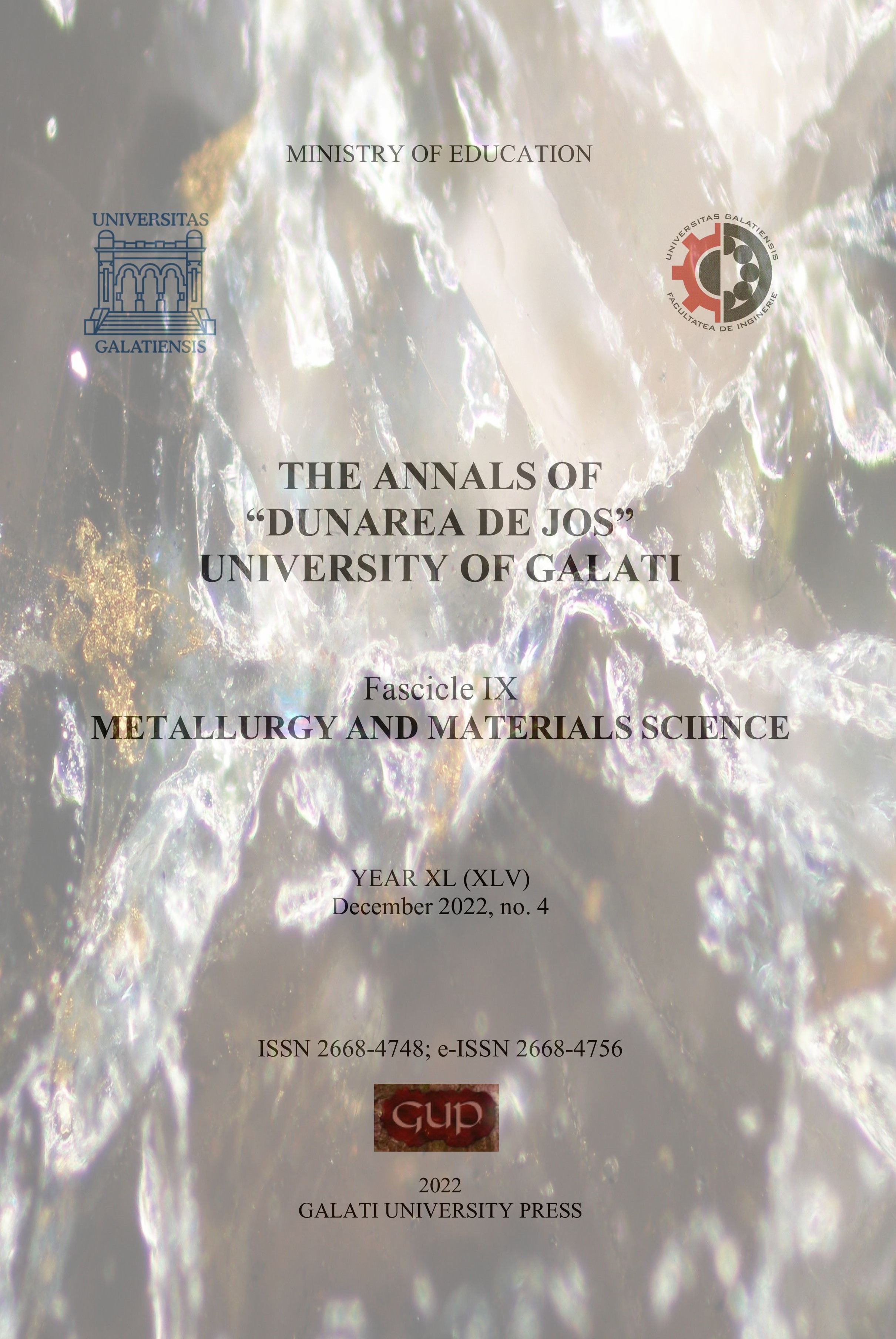Investigation of Structural Characteristics by FTIR Spectroscopy of Chitosan Derivative with N Heterocyclic Compound
Abstract
Chitosan and chitosan derivatives are biomaterials of great scientific interest for biomedical applications although some of the properties are limited as their solubility in the aqueous medium. N-heterocyclic compounds are of interest for chitosan alkylation and new derivatives can be obtained by modification of his structure resulting thus new structures of biomedical interest Chitosan samples from two sources were analysed, in which the dissociation is favoured in the aqueous medium by the presence of a bipyridine salt, N,N'-bis(phenacyl)-4,4'-bipyridinium dibromide. The synthesis of chitosan’ derivate was conducted in aqueous medium at 60 °C, by magnetic stirring for 24 hours. The dissociation is better and reduced the pH, to values lower than pH 6, which suggests the achievement of favourable structural arrangements between chitosan and dibromide bipyridinium. The FTIR spectra parameters indicate the presence of characteristic bands of the bipyridinium salt in the chitosan derivates structures, with structural differences in their composition.
Downloads
References
[2]. Borchard G., Junginger H. E., Modern drug delivery applications of chitosan, Adv. Drug Deliv. Rev, 52, p. 103-150, doi:10.1016/s0169-409x(01)00188-0, 2001.
[3]. Dutta P. K., Ravikumar M. N. V., Dutta J., Chitin and chitosan for versatile applications, J. Macromol. Sci. Phys., 42:3, p. 307-354, doi:10.1081/MC-120006451, 2002.
[4]. Yuan Y., Chestnutt B. M., Haggard W. O., Bumgardner J. D., Muzzarelli R. A. A., In Chitin and chitosan in biomaterial science, edited by R. Jayakumar & A. Prabaharan, Trivandrum, India: Research Signpost, 2008.
[5]. Muzzarelli R. A. A., Chitins and chitosan’s for the repair of wounded skin, nerve, cartilage and bone, Carbohydr Polym, 76(2), p. 167-182, 0144-8617, doi.org/10.1016/j.carbpol.2008.11.002, 2009.
[6]. Bansal V., Sharma P. K., Sharma N., Pal O. P., Malviya R., Applications of Chitosan and Chitosan Derivatives in Drug Delivery, Adv. Biol. Res., 5, 1, p. 28-37, ISSN 1992-0067, doi:360101108, 2011.
[7]. Puvvada Y. S., Vankayalapati S., Sukhavasi S., Extraction of chitin from chitosan from exoskeleton of shrimp for application in the pharmaceutical industry, Int. Curr. Pharm. J., 1(9), p. 258-263, doi.org/10.3329/icpj.v1i9.11616, 2012.
[8]. Irom B. C., Kavitha K., Rupeshkumar M., Jagadeesh Singh S. D., Applications of Natural Polymer Chitosan and Chitosan Derivatives in Drug Delivery: A Review, RJPBCS, 3, 4, p. 309-316, 2012.
[9]. Ahmad S., Ikram S., Chitosan & its derivatives: a review in recent innovations, Inter J Pharmaceutical, 6(1), p. 14-30, doi: 10.13040, 2015.
[10]. Muzzarelli R. A. A., Boudrant J., Meyer D., Manno N., Demarchis M., Current views on fungal chitin/chitosan, human chitinases, food reservation, glucans, pectins and inulin: A tribute to Henri Braconnot, precursor of the carbohydrate polymers science, on the chitin bicentennial, Carbohydr Polym, 8, 7995-1012, doi: 10.1016/j.carbpol.2011.09.063, 2012.
[11]. Gibot L., Chabaud S., Bouhout S., Bolduc S., Auger F. A., Moulin V. J., Anticancer properties of chitosan on human melanoma are cell line dependent, Int J Biol Macromol, 72, p. 370-379, doi:10.1016/j.ijbiomac.2014.08.033, 2015.
[12]. Cheung R. C. F, Ng T. B., Wong J. H., Chan W. Y., Chitosan: An Update on Potential Biomedical and Pharmaceutical Applications, Mar Drugs, 13(8), p. 5156-5186, doi:10.3390/md13085156, 2015.
[13]. Singh R., Shitiz K., Singh A., Chitin and chitosan: biopolymers for wound management, Int. Wound J., 14(6), p. 1276-1289, doi:10.1111/iwj.12797, 2017.
[14]. Elson C. M., Covalently linked N,O-carboxymethyl chitosan, Patent US 5888988, 2000, US5888988A - Covalently linked N,Ocarboxymethylchitosan and uses thereof - Google Patents.
[15]. Cho J., Heuzey M. C., Begin A., Carreau J. P., Gelation study of chitosan/b-glycerophosphate solutions by rheological measurements, In Proceedings of the XIVth international congress on rheology (FB09), Seoul, Korea, web, 2004.
[16]. Mouryaa V. K., Nazma N. Inamdara, Ashutosh T., Carboxymethyl chitosan and its applications, Zair./J. Soc. Mater. Sci. Jpn., 1(1), p. 11-33, doi: 10.5185/amlett.2010.3108, 2010.
[17]. Pokhrel S., Yadav P. N., Functionalization of chitosan polymer and their applications, J. Macromol. Sci., Part A, 56:5, p. 450-475, doi: 10.1080/10601325.2019.1581576, 2019.
[18]. El-Gharably A. A., Kenawy E. R. S., Safaan A. A., et al., Synthesis, characterization and application of chitosan conjugated heterocyclic compounds, J, Polym Res, 29, 141, doi.org/10.1007/s10965-021-02672-1, 2022.
[19]. Dinica R. M., Marchetti F., Pettinari C., Skelton B. W., White A. H., Synthesis, spectroscopic and structural characterization of the reaction products of quaternary cationic 2,20-bipyridylium ligand bromide salts with metal halides, Inorg. Chim. Acta, 360, 2609, doi:10.1016/j.ica.2006.12.037, 2007.
[20]. Sinha V. R., Singla A. K., Wadhawan S., Kaushik R., Bansal R., Dhawan S., Chitosan microspheres as a potential carrier for drugs, Int. J. Pharm., 274, p. 1-33, doi:10.1016/j.ijpharm.2003.12.026, 2004.
[21]. Pillai C. K. S., Paul W., Sharma C. P., Chitin and Chitosan Polymers: Chemistry, Solubility and Fiber Formation, Prog. Polym. Sci., 34, 7, p. 641-678, doi.org/10.1016/j.progpolymsci.2009.04.001, 2009.
[22]. Puvvada Y. S., Vankayalapati S., Sukhavasi S., Extraction of chitin from chitosan from exoskeleton of shrimp for application in the pharmaceutical industry, Int. Curr. Pharm. J., 1(9), p. 258-263, doi.org/10.3329/icpj.v1i9.11616, 2012.
[23]. Mustafa A., Studii fizico-chimice pentru realizarea și caracterizarea unor forme farmaceutice pe bază de chitosan, Rezumat teza, Univ. „Carol Davila”, Buc, 2018.
[24]. Cârâc A., Boscencu R., Dinică R. M., Guerreiro J. F., Silva F., Marques F., Cabral Campello M. P., Moise C., Brîncoveanu O., Enăchescu M., Cârâc G., Tăbăcaru A., Synthesis, characterization and antitumor activity of two new dipyridinium ylide based lanthanide (III) complexes, Inorg. Chim. Acta, 480, p. 83-90, doi: 10.1016/j.ica.2018.05.003, 2018.
[25]. Wang W., Meng Q., Li Q., Liu J., Zhou M., Jin Z., Zhao K., Chitosan Derivatives and Their Application in Biomedicine, Int J Mol Sci., 21(2):487, PMID: 31940963, PMCID: PMC7014278, doi:10.3390/ijms21020487, 2020.
[26]. Hsieh W. C., Chang C. P., Lin S. M., Morphology and characterization of 3D micro-porous structured chitosan scaffolds for tissue engineering, Colloids Surf B Biointerfaces, 57(2), p. 250-255, PMID: 17363229, doi: 10.1016/j.colsurfb.2007.02.004, 2007.



